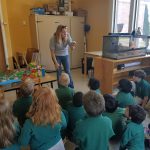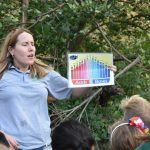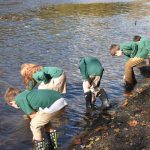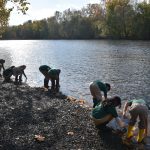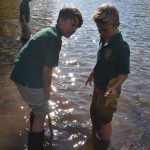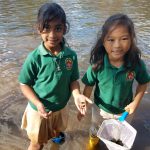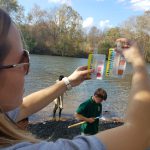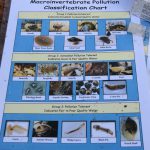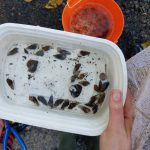On Thursday, the Elementary class enjoyed a 2-part field trip experience about watersheds and water quality. The first part was in the classroom. Diana Andrejczak, the Manager of Education from the Pennsylvania Resources Council, the oldest environmental agency in the state, shared with the class an educational program about watersheds. She led a discussion about the importance of water in the world. She talked about the different forms of water, including salt and fresh, and compared their properties. The students learned that only 1% of all the water in the world is drinkable, and that the entire population of humans and animals depends on that 1%.
To further aid in their understanding of watersheds, Diana brought in a model of a typical watershed. Before she had the students work with it, she discussed possible pollutants that go into the water, including soil runoff, oil, fertilizer, pesticides, and animal droppings. The students learned about our local watershed, and how all the water that goes into the sewer drains and creeks and rivers eventually leads to the Delaware River and, ultimately, the Atlantic Ocean. After this interesting discussion, the students took turns working with the watershed model, pouring different pollutants on it before adding rain water, showing all that goes into watersheds that doesn’t belong there. The students then learned about different strategies to reduce pollution in our waterways, including planting trees, composting food waste, picking up trash, picking up after pets, using safe pesticides and fertilizers, walking and biking more, and recycling old oil.
The second part of the afternoon involved a field test of our local water, in this case going to the Schuylkill Canal at Lock 60. The students tested the Schuylkill River for pH, oxygen, and nitrates, and they caught some macroinvertebrates and some small fish. They also picked up some trash they found. They experienced firsthand how what they do directly impacts something like the Schuylkill River and all its inhabitants.
Also, after the water test, there was a discussion about how the insects were in their larval stage at this time of year. It was mentioned that in the spring many of them will have grown wings. Also, the water may have different pH, oxygen, and nitrate levels in the spring. The students were interested to find out that information, and they asked Diana if she could come back again. So stay tuned for more information about that field trip!
It was wonderful to see the students’ excitement on Thursday. It was a great day for everyone!
